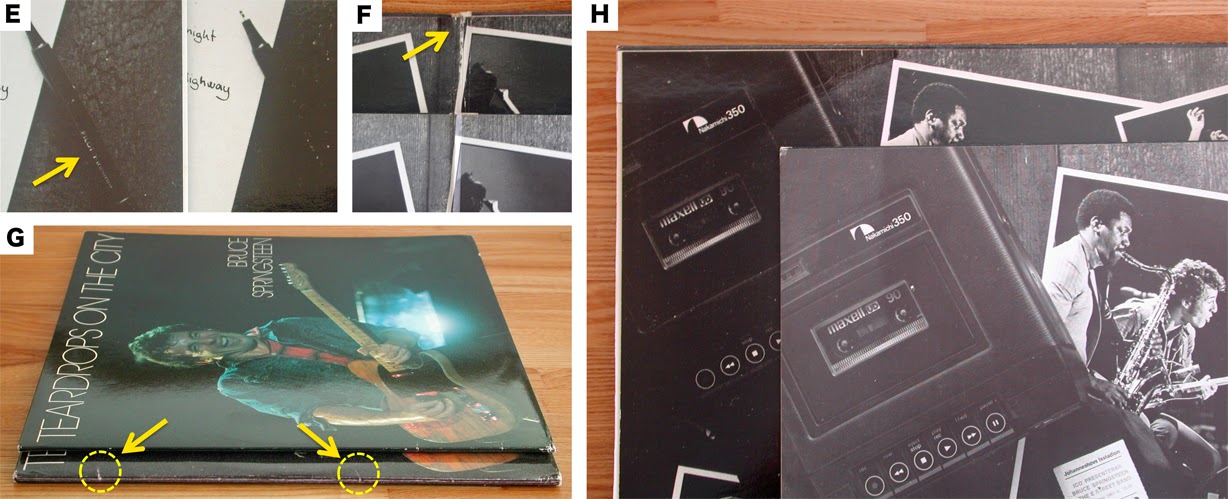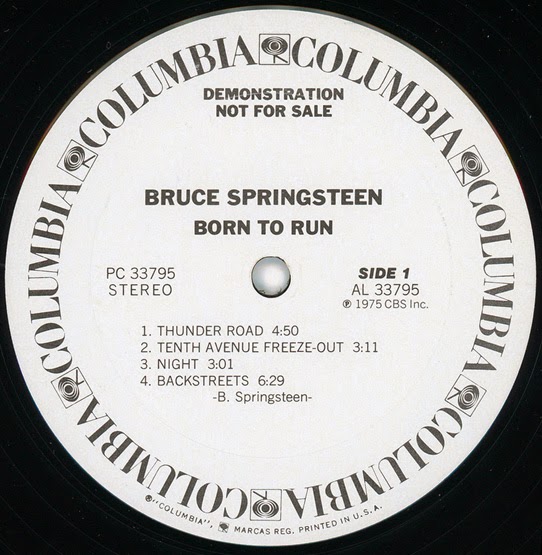"Ridiculously
overpriced, impossible to find even at the ridiculous price, these two
three record sets nonetheless rank as the very best sound quality of any
Springsteen live bootleg and that's saying something.” That's what the author started with when he began to write about two Swedish vinyl bootlegs,
FOLLOW THAT DREAM and
TEARDROPS ON THE CITY, in a short column article entitled
“The essential bootleg album guide” that is featured in the fanzine
Backstreets no. 6 (May 1983).
 |
The five titles of Swedish vinyl bootlegs from the early 1980s.
Upper row: (What I believe) the original pressings. Lower row: The reissues from the mid-1980s. |
Before that bootleg column, however, the fanzine already introduced these Swedish bootlegs in the second issue (1982) right after they were out:
"The best bootlegs by far, perhaps the best bootlegs in the history of bootlegging, are the three Swedish triple sets: TEARDROPS ON THE CITY; FOLLOW THAT DREAM; and MOVING ON TO STOCKHOLM (sic).
All three are three record sets pressed on high quality vinyl, stuck in
attractive four color covers and put together with as much care as a
record company would. The sound quality is as good as any live album
ever released by a rock artist."
These words obviously sound exaggerated now, especially for the
description on the sound quality. As exemplified above, every review on
these bootlegs praises their sound and
BLINDED BY THE LIGHT (P. Humphries & C. Hunt,1985) states "superb" or "excellent" all round production for
FOLLOW THAT DREAM and
TEARDROPS ON THE CITY, respectively. These reputations had built up my expectations only to result in mild disappointment when I first listened to these vinyl sets. In reality, they are audience recordings after all, despite the fact that their sound quality certainly stands above average as
THE RIVER Tour bootlegs.
Generally, vinyl bootlegs from this tour are of low quality in terms of sound (Note: I'm referring to those floating around before the release of
BORN IN THE USA). This is attributable to lack of excellent audience recordings circulated, no FM-broadcast shows available, and only a few soundboard tapes leaked to be bootlegged: to mention a few examples;
NASSAU (12/28/1980; 3LP box) was circulated early and widely but an absolute garbage;
EL BOOS EN BARCELONA (4/21/1981; Single LP), questionably high-priced in the vinyl era possibly due to the limited number, is again awful sound; and
HUNGRY HEART (UK '81 shows; 3LP) is a rare Japanese boot with horrible sound quality. These are in marked contrast to many of the
pre-"THE RIVER" vinyl Brucelegs that are sourced — irrespective of generations — from FM-broadcast or line-recording tapes. BTW, this does not necessary mean that they all sound excellent, but you would agree with my opinion if the sound quality of these Swedish releases were compared to those of, for example,
YOU CAN TRUST YOUR CAR and
LIVE IN THE PROMISED LAND.
 |
Gate-fold Bruceleg releases from 1970s
Upper, LIVE on Coral Records; Lower, LIVE IN THE
PROMISED LAND (a.k.a. WINTERLAND 1978) |
On the other hand, the packaging of these bootlegs, housed in a full-color gate-fold sleeve, is undoubtedly far more impressive than those of the US Brucelegs which often came with so called "slick" or "insert" covers (BTW, I love those good old amateurish appearance of classic vinyl Brucelegs). Before these Swedish releases, I can think of that there was only one Bruceleg title that had been released in a full-color sleeve (i.e.
LIVE on Coral Records) and there were only two that had come in a gate-fold cover (i.e. again
LIVE and
LIVE IN THE PROMISED LAND). So, it would not be difficult for those who weren't then real-time collectors to imagine how high the impact of these Swedish boots were on Bruceleg collectors back then. In fact,
TEARDROPS easily gets my vote for one of the best, if not the best, sleeves of all the Springsteen vinyl bootlegs. These days, if vinyl bootlegs have their value, it is in their existence themselves or packaging rather than as sound media. This may indicate that some of these vinyl releases, if they are well cared for the package or all round production, can be regarded as highly collectibles nowadays even in the digital era (one such Bruceleg title that easily comes up with in my mind is
ALL THOSE YEARS 10-LP box).
The three Swedish titles from
THE RIVER European Tour,
TEARDROPS ON THE CITY,
FOLLOW THAT DREAM and
BORN TO BE THE BOSS, have been repressed in mid-1980s (see the picture above), when the popularity of Springsteen, hence the demand of live bootlegs, reached the peak after the huge success of the
BORN IN THE USA Tour. So, on the next post, I will compare the two different releases of
TEARDROPS ON THE CITY and try to define the original pressing of possibly one of the most sought-after vinyl Bruceleg titles released in early 1980s.
—
To be continued.





















